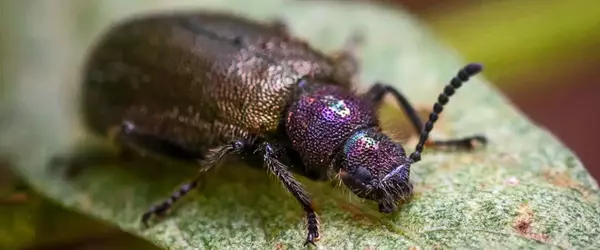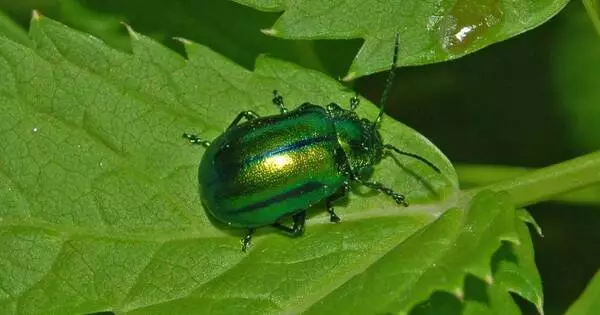In a new study, a research team at the Max Planck Institute for Chemical Ecology in Jena, Germany, demonstrates how leaf beetles evolved to successfully use new and previously indigestible food sources. Through horizontal gene transfer, the insects acquired enzymes from microorganisms that allowed them to degrade pectins, which are solid components of the plant cell wall.
Because the degradation products of pectin digestion are not required for the beetles’ growth and development, the researchers conclude that the beetles disrupt the cell wall in order to gain access to the protein-rich cytoplasm of plant cells, which they require for nutrition.
Fossil evidence of insect feeding damage on plants shows that insects have been using plants as a food source for more than 400 million years. The Department of Insect Symbiosis’ Roy Kirsch and Yannick Pauchet are investigating how herbivorous insects are able to break down the difficult-to-digest components of their plant food in the first place.
They had previously demonstrated that pectin-degrading enzymes are common in herbivorous beetle species. They were also able to show that these beetle enzymes were always of microbial origin. The current study sought to determine how important these enzymes are for the nutrition and fitness of the insect, in this case the mustard leaf beetle Phaedon cochleariae.
Our goal was to better understand how herbivorous insects deal with the plant cell wall, which makes the bulk of their diet. Pectin is the matrix embedding cellulose and hemicellulose fibers within the plant cell wall, and it is the main constituent of the cell-connecting middle lamellae.
Roy Kirsch
“Our goal was to better understand how herbivorous insects deal with the plant cell wall, which makes the bulk of their diet. Pectin is the matrix embedding cellulose and hemicellulose fibers within the plant cell wall, and it is the main constituent of the cell-connecting middle lamellae. Consequently, pectin must be digested first so that cellulase and hemicellulase enzymes can access their substrates and the plant cells are finally freed from their protective cell wall. In this context, the action of pectinases, i.e. pectin-degrading enzymes, are key to efficient digestion of a leaf beetle’s diet,” says first author Roy Kirsch.
To study the role of the pectinases, the researchers generated beetle lines in which these enzymes were not present. This initially turned out to be more difficult than expected.” “Not even a drastic reduction of pectinase activity through knockdown RNAi experiments in leaf beetle larvae was sufficient to effectively inhibit pectin digestion.
We were only able to completely knock-out pectinase-encoding genes in the leaf beetles by applying CRISPR/Cas9 genome editing,” says study leader Yannick Pauchet, underlining the importance of the “genetic scissors,” a technology for which Emmanuelle Charpentier and Jennifer Doudna were awarded the 2020 Nobel Prize in Chemistry.

“Pectinase-null mutant” larvae generated in this way turned out to have low survival capacity. A further question now was whether the degradation products of pectin digestion would improve the survival rate of these beetles when applied orally to the beetle larvae. However, as feeding experiments showed, this was not the case.
“On the one hand, this result was a bit of a surprise for us. But on the other hand, it was an important indicator that leaf beetles do not digest pectin to use its breakdown products for their own metabolism, but rather disrupt pectin, and likely other plant cell wall polysaccharides, to access the protein-rich cytoplasm of plant cells,” Roy Kirsch summarizes the results.
Recent research, including that of Yannick Pauchet’s project group, has shown that the acquisition of microbial enzymes via horizontal gene transfer contributed to the abundance of not only leaf beetle species, but also members of other insect families such as weevils, bark beetles, and stick insects.
The use of enzymes from other microbial organisms is an evolutionary shortcut; in any case, it set the stage for insects to discover pectin-rich plants as a food source in the first place. In fact, it is possible that pectinases first evolved in plants to dynamically adapt the pectin structure to the changing needs of the plant. These enzymes were then taken up by plant pathogenic microbes, who then passed them on to herbivorous insects. Plant adaptation strategies apparently always involve risks and side effects,” says Roy Kirsch.
There are, however, leaf beetle species that contain symbiotic bacteria that produce pectinases for their hosts. Knockin” experiments, in which a pectinase gene is introduced into the beetle genome using CRISPR-Cas9, are now planned to demonstrate how this new beetle trait affects interactions not only between plants and insects, but also between insects and their bacterial partners. Future research will concentrate on enzymes that do not degrade pectin but rather other plant cell wall components.
The research of Roy Kirsch, Yannick Pauchet, and their colleagues demonstrates that adaptation to plant defenses, such as toxins, feeding inhibitors, and other secondary metabolites, is not the only factor in an insect’s survival on a host plant. The scientists are concentrating on primary metabolism, which has previously been overlooked in plant-insect interactions research. According to Yannick Pauchet, “the ability of an insect to digest these primary metabolites is equally important for the evolutionary success of herbivorous insects.”
















